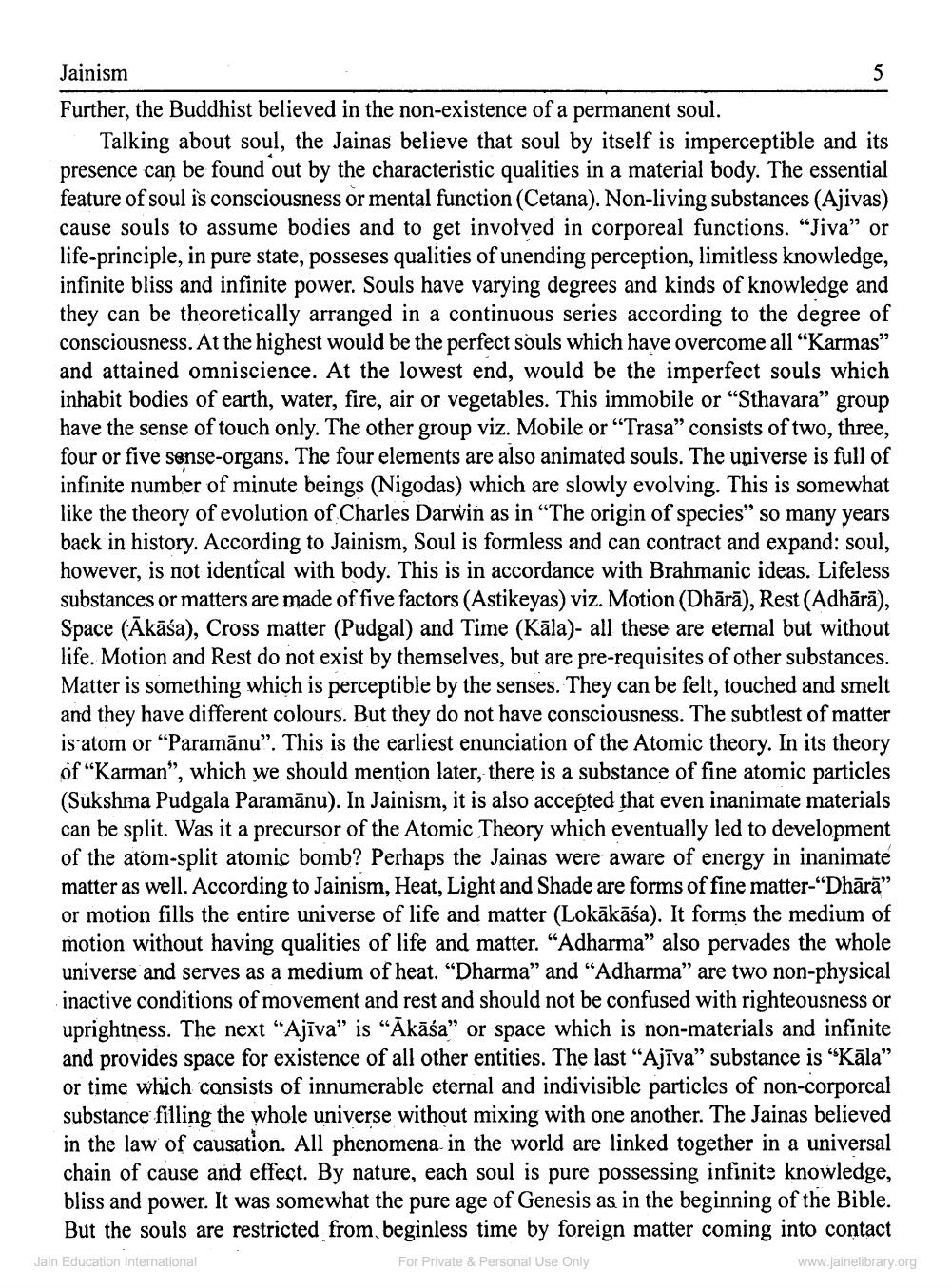________________
Jainism
Further, the Buddhist believed in the non-existence of a permanent soul.
Talking about soul, the Jainas believe that soul by itself is imperceptible and its presence can be found out by the characteristic qualities in a material body. The essential feature of soul is consciousness or mental function (Cetana). Non-living substances (Ajivas) cause souls to assume bodies and to get involved in corporeal functions. “Jiva" or life-principle, in pure state, posseses qualities of unending perception, limitless knowledge, infinite bliss and infinite power. Souls have varying degrees and kinds of knowledge and they can be theoretically arranged in a continuous series according to the degree of consciousness. At the highest would be the perfect souls which have overcome all “Karmas” and attained omniscience. At the lowest end, would be the imperfect souls which inhabit bodies of earth, water, fire, air or vegetables. This immobile or "Sthavara" group have the sense of touch only. The other group viz. Mobile or “Trasa" consists of two, three, four or five sense-organs. The four elements are also animated souls. The universe is full of infinite number of minute beings (Nigodas) which are slowly evolving. This is somewhat like the theory of evolution of Charles Darwin as in “The origin of species" so many years back in history. According to Jainism, Soul is formless and can contract and expand: soul, however, is not identical with body. This is in accordance with Brahmanic ideas. Lifeless substances or matters are made of five factors (Astikeyas) viz. Motion (Dhārā), Rest (Adhārā), Space (Akāśa), Cross matter (Pudgal) and Time (Kāla)- all these are eternal but without life. Motion and Rest do not exist by themselves, but are pre-requisites of other substances. Matter is something which is perceptible by the senses. They can be felt, touched and smelt and they have different colours. But they do not have consciousness. The subtlest of matter is atom or “Paramānu”. This is the earliest enunciation of the Atomic theory. In its theory of “Karman", which we should mention later, there is a substance of fine atomic particles (Sukshma Pudgala Paramānu). In Jainism, it is also accepted that even inanimate materials can be split. Was it a precursor of the Atomic Theory which eventually led to of the atom-split atomic bomb? Perhaps the Jainas were aware of energy in inanimate matter as well. According to Jainism, Heat, Light and Shade are forms of fine matter-“Dhārā” or motion fills the entire universe of life and matter (Lokākāśa). It forms the medium of motion without having qualities of life and matter. "Adharma" also pervades the whole universe and serves as a medium of heat. "Dharma" and "Adharma" are two non-physical inactive conditions of movement and rest and should not be confused with righteousness or uprightness. The next "Ajīva" is “Akāśa" or space which is non-materials and infinite and provides space for existence of all other entities. The last “Ajīva" substance is “Kāla" or time which consists of innumerable eternal and indivisible particles of non-corporeal substance filling the whole universe without mixing with one another. The Jainas believed in the law of causation. All phenomena in the world are linked together in a universal chain of cause and effect. By nature, each soul is pure possessing infinite knowledge, bliss and power. It was somewhat the pure age of Genesis as in the beginning of the Bible.
But the souls are restricted from beginless time by foreign matter coming into contact Jain Education International For Private & Personal Use Only
www.jainelibrary.org




